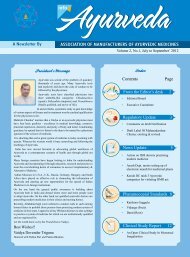Wishing You Happy Dhanwantari Jayanti Happy Diwali & A ...
Wishing You Happy Dhanwantari Jayanti Happy Diwali & A ...
Wishing You Happy Dhanwantari Jayanti Happy Diwali & A ...
Create successful ePaper yourself
Turn your PDF publications into a flip-book with our unique Google optimized e-Paper software.
BIBHITAKA (Fruit)<br />
SYNONYMS<br />
Sanskrit : Vibhitaka, Aksha, Akshaka<br />
Assamese : Bhomora, Bhomra, Bhaira<br />
Bengali : Bayada, Baheda<br />
English : Beleric Myrobalan<br />
Gujrati : Bahedan<br />
Hindi : Bahera<br />
Kannada : Tare kai, Shanti Kayi<br />
Kashmiri : Babelo, Balali<br />
Malayalam : Tannikka<br />
Marathi : Baheda<br />
Oriya : Baheda<br />
Punjabi : Bahera<br />
Tamil : Thanrikkai<br />
Telugu : Thanikkaya<br />
Urdu : Bahera<br />
Bibhitaka consists of pericarp of<br />
dried ripe fruits of Terminalia belerica<br />
Roxb. (Fam. Combretaceae), a large<br />
deciduous tree, 10-12 m or more high,<br />
commonly found in plain and forests<br />
upto 900 m elevation, fruits ripen<br />
towards November.<br />
DESCRIPTION<br />
a) Macroscopic<br />
Fruit nearly spherical to ovoid, 2.5-4.0 cm in diameter, fresh ripe fruits<br />
slightly silvery or with whitish shiny pubescent surface, mature fruits gray<br />
or grayish brown with slightly wrinkled appearance, rind of fruit shows<br />
variation in thickness from 3-5 mm, taste, astringent.<br />
b) Microscopic<br />
Transverse section of fruit shows an outer epicarp consisting of a layer of<br />
epidermis, most of epidermal cells elongate to form hair like protuberance<br />
with swollen base, composed of a zone of parenchymatous cells, slightly<br />
tangentially elongated and irregularly arranged, intermingled with stone<br />
cells of varying shape and size, elongated stone cells found towards<br />
periphery and spherical in the inner zone of mesocarp in groups of 3-10,<br />
mesocarp traversed in various directions by numerous vascular strands,<br />
bundles collateral, endarch, simple starch grains and some stone cells found<br />
in most of mesocarp cells, few peripheral layers devoid of starch grains,<br />
rosettes of calcium oxalate and stone cells present in parenchymatous<br />
cells, endosperm composed of stone cells running longitudinally as well<br />
as transversely.<br />
IDENTITY, PURITY AND STRENGTH<br />
Foreign matter: Not more than 2 per cent,<br />
Total Ash: Not more than 7 per cent,<br />
Acid-insoluble ash: Not more than 1 per cent,<br />
Alcohol-soluble extractive: Not less than 8 per cent,<br />
Water-soluble extractive: Not less than 35 per cent,<br />
CONSTITUENTS<br />
Gallic acid, tannic acid and glycosides<br />
PROPERTIES AND ACTION<br />
Rasa: Kashaya<br />
Guna : Ruksha, Laghu<br />
Veerya : Ushna<br />
Vipaka : Madhura<br />
Karma: Kaphapittajit, Bhedaka, Kriminaashana, Cakshushya, Keshya,<br />
Kaasahara<br />
IMPORTANT FORMULATIONS<br />
Triphala Churna, Triphaladi Taila, Lavangaadi Vati.<br />
THERAPEUTIC USES<br />
Svarabheda, Netraroga, Kasa, Chardi, Krimiroga, Vibandha<br />
DOSE<br />
3-6 g of the drug in powder from<br />
DHATAKI (Flower)<br />
SYNONYMS<br />
Sanskrit : Bahupuspi, Taamrapushpi, Vahnijvala<br />
Assamese : Dhaiphool<br />
Bengali : Dhaiphul<br />
English : Fire flame bush<br />
Gujrati : Dhavadi, Dhavani<br />
Hindi : Dhai, Dhava<br />
Kannada : Dhataki, Tamrapushpi<br />
Malayalam : Tattiripuvu, Tatire<br />
Marathi : Dhayati, Dhavati<br />
Oriya : Dhaiphula, Dhatuki<br />
Punjabi : Davi, Phul Dhava<br />
Tamil : Kattati, Kattathi, Kattattipoo<br />
Telugu : Aarl Puruvu<br />
Dhataki consists of flowers of<br />
Woodfordia fruticosa (Linn.) Kurz.<br />
(Fam. Lythraceae) : much branched,<br />
semi deciduous, undershrub or shrub,<br />
1-3 m high, rarely upto 3 m, found<br />
throughout India, ascending to 1500 m<br />
in Himalayas and also in the Gangetic<br />
plains, also cultivated in gardens.<br />
DESCRIPTION<br />
a) Macroscopic<br />
Flower, about 1.2 cm long, occurs as single or in bunches of 2-15, calyx<br />
1.0-1.6 cm long, ridged and glabrous, bright red when fresh but fades on<br />
drying, with campanulate base and oblique apex having 6 triangular and<br />
acute teeth, each tooth being, 2-2.5 mm long, 6, very minute accessory<br />
sepals attached outside at the juncture of calyx tooth and deeper in colour,<br />
petals 6, attached inside the mouth of calyx-tube, shightly longer than<br />
calyx tooth, alternating with calyx-tooth pale rose or whitish, thin, papery,<br />
lanceolate, acuminate, stamens 12, united at the base, about 1.5-2 cm<br />
long, filament filiform, curved at the apex, keeping anthers inside calyxtube<br />
, anthers dorsifixed brown, almost rounded or broadly ovate, carpels<br />
2, united, ovary superior, style filiform, longe, than ovary and stamens,<br />
taste, astringent.<br />
b) Microscopic<br />
Transverse section of sepal shows, single layered cuticularised epidermis,<br />
provided with both glandular and covering trichomes; glandular<br />
trichomes, multicellular, long, consisting of a stalk and a globose, thinwalled,<br />
multicellular head, covering trichomes, unicellular thick-walled<br />
broad at base and pointed at the apex, ground tissue consisting of thinwalled,<br />
parenchymatous cells surface view of petal shows thin-walled,<br />
parenchymatous cells, provided with very few sparsely distributed covering<br />
trichomes, transverse section of filament shows, epidermis consisting of<br />
single layered tangentially elongated cells, covered with a very thickcuticle,<br />
ground tissue consisting of thin walled parenchymatous cells with<br />
intercellular spaces, surrounding a central. vascular cylinder of spirally<br />
thickened vessels, transverse section of anther shows, single layered<br />
epidermis, covered with cuticle followed by several layers of thickened<br />
cells, surrounding both the pollen-sacs having numerous pollen grains,<br />
pollen grains roughly tetrahedral with three pores, measuring 12-16 μ<br />
approximately, central region consisting of thin-walled cells emboding<br />
vascular bundles.<br />
IDENTITY, PURITY AND STRENGTH<br />
Foreign matter: Not more than 2 per cent,<br />
Total Ash: Not more than 10 per cent,<br />
Acid-insoluble ash: Not more than 1 per cent,<br />
Alcohol-soluble extractive: Not less than 7 per cent,<br />
Water-soluble extractive: Not less than 28 per cent,<br />
CONSTITUENTS Tannins and glucosides<br />
PROPERTIES AND ACTION<br />
Rasa : Kashaya, Katu<br />
Guna : Laghu<br />
www.amam-ayurveda.org 7


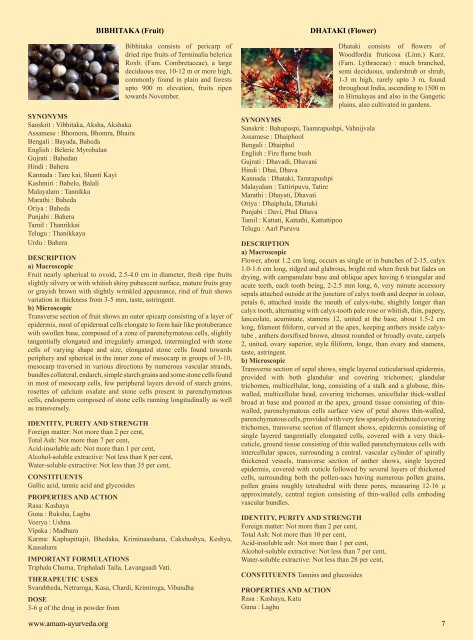

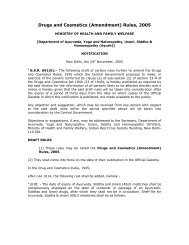
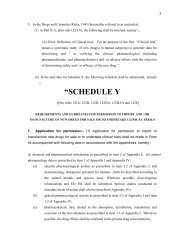
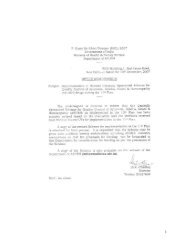

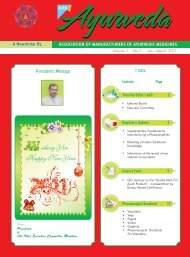


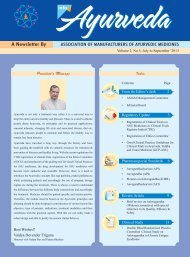
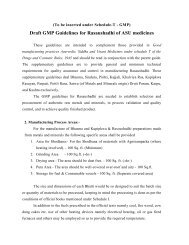
![[To be published in Gazette of India Part II Section 3, sub-section iii]](https://img.yumpu.com/28570283/1/190x245/to-be-published-in-gazette-of-india-part-ii-section-3-sub-section-iii.jpg?quality=85)

